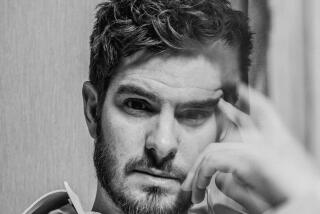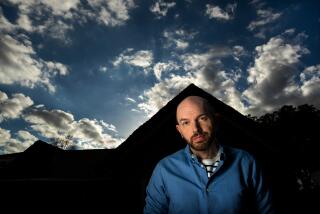Josh Brolin’s memoir presents a series of vignettes starring the actor as himself

- Share via
Book Review
From Under the Truck: A Memoir
By Josh Brolin
Harper: 240 pages, $30
If you buy books linked on our site, The Times may earn a commission from Bookshop.org, whose fees support independent bookstores.
One day in January 1985, 16-year-old Josh Brolin was in Los Angeles filming the climactic scene in his debut film, “The Goonies.” In the largest and deepest soundstage at Warner Bros. Studios, he and the other young actors who made up the eponymous gang were led backward, their hands over their eyes, down a ramp and into water. They were to be fully submerged, and when a signal was given, they would pop up, turn around and take in their surroundings — an underground grotto and its eye-catching, jaw-dropping focal point, a treasure-loaded pirate ship. Director Richard Donner wanted to capture their genuine awestruck reaction. But Brolin’s reaction proved too authentic. When he came up for air, he promptly polluted it — and ruined the shot — by detonating two F-bombs.

This is representative of a number of other anecdotes in Brolin’s new memoir: short and snappy, colorful and witty. He is reckless and unrestrained in the story and candid and unfiltered in the telling of it. Here is a man who speaks his mind, broadcasts his feelings, makes mistakes — and gets there in the end.
“From Under the Truck” is not your average memoir. Instead of a linear narrative of chronological events, Brolin’s account darts backward and forward through the years and resembles a jumbled patchwork of recollections and meditations. In places it is scrappy and disjointed. But there is method in Brolin’s madness because he manages to keep the whole thing hanging together, captivating his reader with his take on what, to date, has been a tumultuous life and a varied career.
Brolin’s early years appear in scattered segments. Growing up on a ranch in Paso Robles, Calif., with his parents and younger brother, he would wake before first light to load a Chevy truck with bales of hay and, with two phone books under his backside, make the rounds feeding 40 horses. When he was 11, the family moved to Santa Barbara and his best friend killed himself. Brolin spent his early teenage years juggling two identities: At night he worked as a cook in an Italian restaurant; during the day he ran wild as a rebel without a cause, or a purpose, in the Cito Rats, “my misfit hive that I was at the epicenter of.”
While his band of brothers crashed and burned, Brolin got a lifeline through his acting break. A career path opened up, but he still pursued a wayward course with drink, drugs and bouts in jail. Two chapters show him at especially low ebbs. In one dated 1990, he recalls staying in a flophouse and aimlessly wandering the seedier streets and slums of Portland, Ore., on the off chance that Gus Van Sant might “discover” him and cast him in “My Own Private Idaho.” In a bleaker episode dated two years later, we find him living alone in a “rented cell” in New York City, bewailing his failures as a husband and father, and, shirtless and shoeless, buttonholing rising star Philip Seymour Hoffman in a subway station.
In happier sections, Brolin records his reversals of fortune, from his second marriage to his career resurgence (following two decades making “dreck and fodder”). There are tender moments in which he spends quality time with his four children or worries about their safety, and even one or two inspiring moments, such as a near-death experience in Costa Rica that hardened his resolve to return to the country. “It haunted me, what happened,” Brolin writes, “and whatever haunted me I had to confront again and again until it either killed me or ceased to have that power.”
Still haunting Brolin is what he calls “the perpetual apparition of Jane.” His late mother, Jane Agee Brolin, was a dynamic — and often manic — force in his life. “She refuses to not be a presence,” Brolin writes, and to prove it she returns again and again in the book, each time looming large and stealing scenes. Throughout, Brolin regales us with outlandish facts. She was a flight attendant in her early 20s but was afraid to fly unless she was drunk. She would insult and then outdrink cowboys and truckers. She slept with a loaded 9-millimeter pistol on her bedside table and once pointed a rifle at her boyfriend because she didn’t want him to leave. She was rumored to be on someone’s hit list. She collected stray animals — not cats and dogs but mountain lions, wolves and coyotes. She lived fast and drove faster and died when she crashed at speed into a tree.
Jane gave her son his self-destructive streak and his capacity to drink. However, it isn’t clear whether Brolin’s other parent, actor James, influenced his choice of career. We hear of a father-son hunting trip and a nice description of James returning home from work in L.A. and “shaking whatever fiction he’d just been living down south out of his head so he could get back into the nonfiction that was us,” but for the most part he remains a distant figure in the book.
Brolin covers a range of other topics. He tells of travels, motorcycle rides and his battles with booze. There are stories involving John Travolta “healing” Marlon Brando and Brolin irritating Robert De Niro. One informative chapter comprises journal entries that chronicle the making of “The Goonies” and Brolin’s great comeback movie, “No Country for Old Men” (2007). Another chapter unfolds as a two-person scene in a film script between Brolin and his director in “W.” (2008), Oliver Stone.
There are flaws. Some of the chapters are mere vignettes that lack substance and bite. Some stories meander and then peter out. And some are infused with skewed imagery: “words that come to him like ghosts feeding chickens handfuls of pellets.” Readers looking for anecdotes about Brolin’s performance in the 2008 biopic “Milk,” which earned him an Oscar nomination for supporting actor, will be disappointed.
Fortunately, Brolin hits more often than he misses, particularly with the raw, rough-edged beauty of his prose. His trip down memory lane might consist of detours, wrong turns and dead ends, but ultimately it is an invigorating and insightful journey.
Malcolm Forbes is a freelance writer and critic from Edinburgh, Scotland, who writes for the Economist, the Washington Post and other publications.
More to Read
A cure for the common opinion
Get thought-provoking perspectives with our weekly newsletter.
You may occasionally receive promotional content from the Los Angeles Times.










